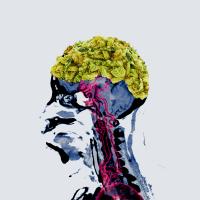Over a 10 year period, Dominic Milton Trott self-administered 157 psychoactive drugs and documented his experiences on each one. He then created the book, The Drug Users Bible, to inform curious minds about safe drug use.
Trott’s reason for going to such great lengths? Illicit drug research is incredibly scarce, due to the legal difficulty of obtaining substances for scientific studies. Other than a few fairly informal scientific rankings regarding the safety of recreational drugs, there isn’t much official information available.
Facts About Drug Use in the United States
According to the most recent government-sponsored research, it’s estimated that 24.6 million Americans have used some type of illicit drug in the past 30 days.
The Centers for Disease Control and Prevention report that overdose deaths due to recreational drug use in the U.S. have been steadily increasing since 1970. In 2017, over 70,000 individuals died as the result of an overdose while using either an illicit drug or a prescription opioid.
With steadily increasing rates of both illicit drug use and overdose deaths, one can easily argue that the country is losing the War on Drugs. In spite of ever-evolving legislation regarding illicit drugs, these statistics about drug use seem to reveal that creating new laws hasn’t been working.
Trott’s Inspiration for The Drug Users Bible
While Trott was performing initial research before trying ayahuasca for the first time, he began to notice the strange disappearance of former participants on internet forums about drug use.
“It was hard not to miss the fact that posters would occasionally just disappear off the radar.” When he realized his online friends were fataling overdosing, he says, “That’s when it started to occur to me that there’s a real problem here. The problem is that people are dying from ignorance. They’re dying because they’re making fundamental mistakes.”
In Trott’s opinion, overdose deaths occur primarily because people lack access to information on safe drug use. So he decided to write a guide, The Drug Users Bible, which he developed for the purposes of harm reduction, risk mitigation, and increased personal safety.
What You’ll Find in Trott’s Book
Trott’s book contains complete descriptions of each of the 157 drugs he tried and his subjective experiences. For substances like methamphetamine, oxycodone, ephenidine, heroin, ketamine, and ayahuasca, Trott’s book documents onset time, dosing, duration of effects, possible contraindications, and the likely effects of the substance.
He also includes details such as whether he experienced a compulsion to take more, would have felt safe in public, or if he underwent a loss of sensibilities.
In addition to a complete report on the substances, Trott created a section called the “10 Commandments of Drug Use.” These 10 Commandments are blanket safety guidelines for recreational drug use, which he designed to mitigate risk.
The Media’s Response
Although Trott believes that education saves lives, and it’s the reason he set out to write his book, The Drug Users Bible has been subject to heavy censorship on social media and other advertising outlets.
With ads blocked, posts removed, pages taken down, and sharing prevented, most social media networks have only responded to Trott’s inquiries regarding the censorship with blanket statements about violating community rules. Some have responded that his book is considered “drug paraphernalia.”
This couldn’t be further from the truth. The intention of Trott’s book is not to encourage drug use; it’s to make drug use safer for those who have already made the decision to use.
Trott poses the question, “If your son or daughter were going to take a drug, would you prefer that they went into this blind, without any safety knowledge at all, or would you prefer that they were armed with risk mitigation procedures, accurate dosing information, onset values, and all the data that will help them to take it and navigate it safely?”
Does “Just Say No” Really Work?
While Trott set out to make drug use safer by eradicating ignorance, his novel ideas might also change the way we think about the War on Drugs.
In a perfect world, the idea of just saying “no” and completely abstaining from potentially harmful activities would be enough to keep people from participating. Unfortunately, we don’t live in a perfect world, and sometimes, people choose to say “yes,” instead.
Take for example, the parallel of teaching teenagers abstinence, without discussing other aspects of sex education, like how to protect yourself and your partner from STDs and how to prevent pregnancy. With regard to sex education, teaching abstinence alone has been shown to be ineffective at helping teens make responsible decisions.
The steadily increasing rates of overdose deaths show that teaching or legislating abstinence from drug use is also ineffective.
“There’s no need to take risks,” Trott says. With his book, Trott makes the argument that people deserve to have access to information that will help them protect themselves, if they choose to say “yes” to potentially risky behaviors.
For more from our Dope Science series, subscribe to Freethink.
-
Research the substance and know what you’re getting yourself into.
-
Source carefully.
-
Test the substance for purity.
-
Carefully consider your dose. You can always take more, but you can’t take less.
-
Weigh your dose, using a high-quality scale.
-
Perform an allergy test.
-
Consider your mental and physical health. Don’t take anything if either is sub-par.
-
Plan experience parameters to prevent rash decisions by restricting dose availability, creating a safe environment, and having food and water available.
-
Write down what you’re taking, how much, and at what time, and pin this to a prominent location on your body. Keep contact numbers for emergency services at hand.
-
Give your body and mind plenty of time to recover before using again.


